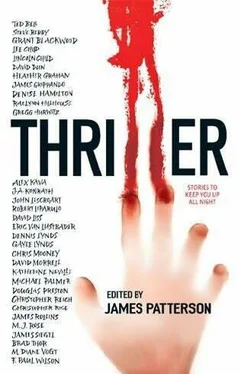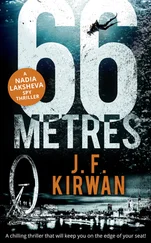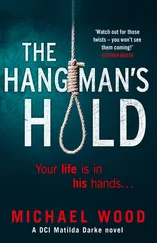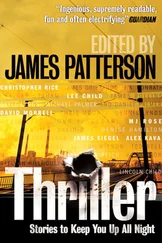As Point Guard and the ambassador turned the next corner, the pair could see the embassy's dark, armor-plated BMW and began running even faster. They were almost there.
Suddenly, a motorcycle screamed out of a nearby alleyway. Point Guard reached for his gun, but he was too late.
One week later Dodecanese Islands Southeastern Aegean, Greece
Lying in the tall grass one hundred meters from a sprawling, whitewashed villa, Scot Harvath used the Leupold Mark 4 scope and Universal Night Sight of his SR25 Knights Armament battle rifle to search for any sign of Theologos Papandreou, the man U.S. Intelligence had fingered as the mastermind behind the murder of Ambassador Avery and his multiagency security detail.
As a Navy SEAL, and now as a covert counterterrorism operative for the U.S. government, Harvath had spent the better part of his professional life pulling a trigger. One of the sadder truths he had learned was that there were a lot of people in the world who needed to be killed. He tried to remind himself that more often than not, the people on the receiving end of his lead-tipped missives were beyond reasoning with. They posed serious threats to the stability and safety of the civilized world and had to be taken out.
Tonight, though, Harvath had his doubts. Something didn't feel right.
Before leaving D.C., Harvath had been fully briefed on the murder of Ambassador Avery. Two years prior, a Greek company headed by a man named Constantine Nomikos had approached the United States to partner up on a technology venture. They were developing a revolutionary new system to better track their fleet of next-generation tanker and cargo ships worldwide. Nomikos needed heavy access to satellite and radar systems to further his research. While reviewing the project, the U.S. had noted several excellent military applications and immediately jumped into bed with them. It wasn't until later in the development process that the Defense Department discovered the device's full potential.
Anything with an electronic guidance system-aircraft, missiles, ships-could be rendered completely invisible to radar. But that was only the half of it. The device could also override guidance systems and remotely control an object's course, speed, tra-jectory-you name it. With the right satellite uplinks, a missile could be diverted off course or a plane could be hijacked without terrorists ever having to set foot on board.
The Defense Department deemed it one of the most exciting and dangerous pieces of technology ever developed. They also gave it its code name, the Achilles Project.
Two weeks prior to Ambassador Avery's assassination, the device had been stolen from Nomikos's research and development facility near the Athenian port of Piraeus. Shortly thereafter, an unidentified organization contacted the U.S. embassy in Athens and offered to sell it back to the United States. Avery and his team had been participating in an operation to recover the device when they were killed.
Despite the fact that a firebomb had been tossed into the car after the shooting and the bodies were burned beyond recognition, ballistics reports indicated that the weapon used to kill Ambassador Avery, as well as the CIA operative accompanying him, was a.45-caliber automatic-the same.45 caliber used in a string of high-profile assassinations attributed to the Greek terrorist organization 21 August.
The name 21 August corresponded to the organization's first attack. On August 21, 1975, they shot and killed the CIA's Athens chief and deputy chief of station. In a long and rambling letter to a left-wing Athenian newspaper, they claimed credit for the murders, spelled out their Marxist-Leninist beliefs and outlined their plans for ridding Greece once and for all of any Western-specifically American-influences.
Be that as it may, the current president of the United States had different plans for 21 August. He was furious that in a country of only eleven million, the Greeks couldn't seem to lay their hands on what every Western intelligence agency agreed was a cell of no more than ten or fifteen people. The "Athens Problem," as it had become known in Western intelligence circles, had been a problem for too long, and he wanted it stopped. He wanted 21 August neutralized before they could mount any more attacks against American interests or, God forbid, sold the Achilles device to one of America's enemies.
The CIA had tentatively identified Papandreou, an associate of Constantine Nomikos, as a key personality behind 21 August. Evidence also suggested he had a hand in the attacks upon Ambassador Avery and his team. The dots didn't connect for Har-vath as cleanly as he would have liked-and certainly not cleanly enough to base a decision to take a man's life, but nevertheless, he had his orders. He had been sent to Greece to take Papandreou out as quickly as possible and recover the Achilles device by any means necessary. Adding to the mission's urgency, the CIA had just learned that 21 August had a buyer for the device-an unidentified Jordanian national, and the transaction was going to take place any day.
Still dubious about the intelligence the U.S. had gathered from its Greek sources, Harvath glanced at his Kobold tactical wrist-watch and wondered where the hell his target was. Papandreou should have been here by now.
Suddenly, the sound of the ocean crashing on the rocky beach below was replaced by the sound of tires crunching down the villa's long gravel drive. Harvath readied his rifle and pressed himself flatter against the damp earth. He prayed to God his superiors back in Washington weren't making a mistake.
A blue Land Rover rolled to a stop before the large double doors of the house. When the driver's door opened Harvath peered through his scope, but it was no good. He couldn't see the man's face. He'd have to wait for him to exit the vehicle.
"Norseman, can you properly ID the target?" said a voice over his headset, thousands of miles away in the White House Situation Room.
"Negative," replied Harvath. "Stand by."
Pressing his eye tighter against his scope, Harvath strained to get a positive identification on Papandreou so he could do his job and pull the trigger.
"Norseman, satellite is giving us only one, I repeat one individual in that vehicle. Can you confirm the subject's identity? Do we have our man?"
Command-and-control elements in the rear always wanted to know everything that was going on in the field. Harvath, though, couldn't give them a play-by-play and pay full attention to his assignment, so he gave them the field operative's polite equivalent of shut the hell up, "Clear the net."
The chatter on his headset fell silent and Harvath watched as the driver began to exit the vehicle. From where he was positioned, he'd have to wait until the man came around the Land Rover and made it to the double doors of the villa before he had not only a clear view of his face but also a clean shot to take him out.
"Ten seconds until subject ID," said Harvath, more for his own benefit than the men and women gathered in the Situation Room.
Three more steps, Harvath thought to himself as the man rounded the grille of the Land Rover.
It was hot and Harvath could feel beads of perspiration collecting on his forehead. What if this wasn't the right guy?
As the man's head came into view, Harvath took a deep breath, held it, but delayed applying pressure to the trigger of his SR25. A few more steps, he thought to himself. A few more steps.
Suddenly a shot rang out and Harvath's target fell face-first in a spray of blood onto the gravel drive.
"What the-" Harvath whispered into his microphone.
"Norseman," came the voice from the Situation Room. "What just happened?"
Harvath scanned the area as best he could with his scope. "We have another shooter on-site and the subject has been downed. Who else is on this job?"
Читать дальше












